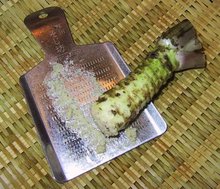| Wasabi | ||||||||||||||
|---|---|---|---|---|---|---|---|---|---|---|---|---|---|---|
| Scientific classification | ||||||||||||||
| ||||||||||||||
| Binomial name | ||||||||||||||
| Wasabia japonica |
Wasabi (Japanese: scientific name Wasabia japonica (syn. Cochlearia wasabi, Eutrema japonica)) is a member of the cabbage family. Commonly known as Japanese horseradish, it grows naturally along stream beds in mountain river valleys in Japan. It is green, and has an extremely strong flavor. Its hotness is different from that of chile peppers, which burn the tongue; wasabi produces vapors that burn the sinus cavity instead.
Consumption
It is sold either in root form, which must be finely grated before use, or as a dried powder which is then mixed with water to make a paste. In both cases, the hot taste develops after a few minutes; both the ungrated root and the dry powder taste rather dull. It is also sold as a ready-to-use paste, which comes in tubes approximately the size and shape of travel toothpaste tubes.
Fresh leaves of wasabi can also be eaten and have some of wasabi root's hot flavor. They can be eaten as wasabi salad by pickling overnight with little salt and with a vinegar based dressing, or by quickly boiling them with a little soy sauce.
Uses

Fortunately for those who either through malice or unfamiliarity come into contact with too much of this condiment, the burning sensations it can induce are short-lived compared to the effects of chiles. When used as intended, it is also very tasty on roasted peas, or in small amounts on sushi or sashimi. Wasabi is commonly mixed with soy sauce to make a dipping sauce for sushi and sashimi. However, wasabi's flavor dissolves very quickly in water and the best way to enjoy wasabi is to apply wasabi after dipping into soy sauce or carefully avoiding wasabi from mixing with soy sauce.
Chemistry
The chemicals in wasabi that provide its unique flavor are the isothiocyanates, including:
- 6-methylthiohexyl isothiocyanate,
- 7-methylthioheptyl isothiocyanate and
- 8-methylthioocytl isothiocyanate.
Research has shown that isothiocyanates have beneficial effects such as inhibiting microbe growth. This may partially explain why wasabi is traditionally served with seafood, which spoils quickly. However, if the quality of your seafood is questionable, do not eat it raw, with or without wasabi. It certainly is not a treatment for food poisoning.
Cultivation
Since there is a severe lack of places suitable for large-scale wasabi cultivation, most of the "wasabi" served today is really just European horseradish dyed green, or a mix of horseradish with black mustard and chlorophyll for the same effect. In Japan, wasabi is cultivated in:
The demand for real wasabi is very high. Japan has to import a large amount of it from:
Without proper regulation, wasabi cultivation can be a major pollutant to rivers as it usually requires fertilizer such as chicken manure and constantly flowing water.
Preparation
It is strongly suggested not to use a mass-produced metal oroshigane to grate wasabi. The best tool to use is made of dried sharkskin (›«v®) with fine skin of one side and coarse skin on the other side. A hand-made grater with irregular teeth could also be used. Without proper tools and technique, wasabi's flavor could be compromised.

